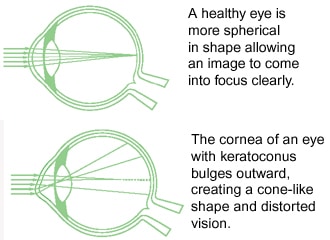Keratoconus
Causes of Keratoconus
Although many theories have been proposed, there is not one definite known cause of keratoconus. Possible etiologies include genetics, collagen deficiencies, and excessive eye-rubbing.

Signs & Symptoms of Keratoconus
Keratoconus can be difficult to detect because it usually develops very slowly. Signs of keratoconus may include:
- Distorted and blurred vision
- Myopia (nearsightedness)
- Astigmatism
- Double vision
- Headaches due to eye strain
- Glare
- Light sensitivity
Your eye doctor will measure the curvature of your cornea to determine whether these symptoms are a result of keratoconus.
Treatment for Keratoconus
In the early stages of keratoconus, glasses or soft contact lenses may correct the nearsightedness and astigmatism associated with the disease. As the condition progresses and the cornea becomes increasingly thin, more advanced treatment is required. Treatment options include:
Rigid Gas-Permeable Contact Lenses, Scleral Lenses and Specialty Contact Lens Designs
If optimum vision is not achieved with eyeglasses or soft contact lenses, rigid gas-permeable (RGP) contact lenses, scleral lenses and specialty contact lens designs are used as a form of vision correction. The specialty lens covers the cornea and replaces the cornea’s irregular shape with a smooth and uniform refracting surface. As a result, vision is improved.
The adaptation for wear-time of these specialty lenses varies depending on the type of lenses that are prescribed. The fitting process for these lenses take longer than the fitting process for conventional soft contact lenses as each person’s cornea is unique. These lenses are designed to custom-fit your eye. If you are using specialty contact lenses, you will need to visit your doctor frequently to adjust the fit and prescription of the lenses as your keratoconus continues to progress.
Collagen Cross-Linking
Collagen cross-linking is a relatively new method for treating keratoconus. It works by strengthening the corneal tissue to slow down the thinning process. In this procedure, eye drops that contain riboflavin (vitamin B2) are applied to the cornea and then activated by ultraviolet light. This strengthens the collagen fibers within the cornea. Although approved in Europe, this procedure is undergoing FDA approval in the United States.
Corneal Transplant Surgery
Surgery is needed for patients with advanced keratoconus, especially if scarring has occurred. This treatment is usually recommended for 15-20% of cases. In corneal transplant surgery, most of the host cornea is removed and then replaced with a new donor cornea. The success rate of this procedure is over 97%.




